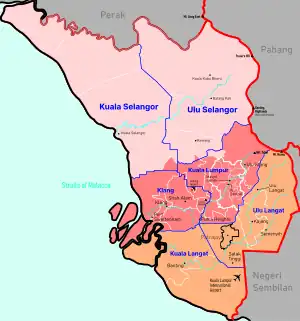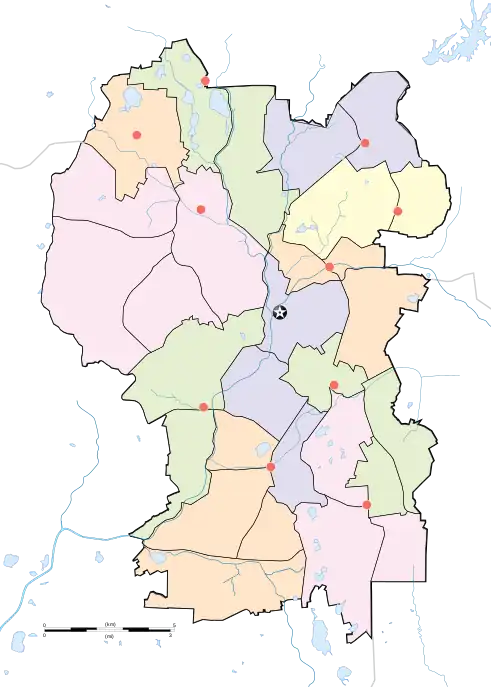Greater Kuala Lumpur
Greater Kuala Lumpur is the geographical term that determines the boundaries of metropolitan Kuala Lumpur in Malaysia. Though similar to the term "Klang Valley", there remains a variation between the two. It is similar to Greater London and Greater Toronto. The metropolitan area covers 5,194.72 square km of land.
Greater Kuala Lumpur | |
|---|---|
From top, clockwise: Kuala Lumpur, Petaling Jaya, Genting Highlands, Putrajaya, Seremban, Klang, Shah Alam | |
| Country | Malaysia |
| Region | Federal Territories Selangor Pahang Negeri Sembilan |
| Area | |
| • Total | 5,194.72 km2 (2,005.69 sq mi) |
| Population (2020) | |
| • Total | 8,455,029 |
| • Density | 2,708/km2 (7,010/sq mi) |
| Time zone | UTC+8 (MST) |
| Area code(s) | 03 |

History
Pre-1974
Kuala Lumpur has been declared the capital city of Federated Malay States in 1896, and when the group of states changes and expands to Federation of Malaya and later Malaysia, the town status has been kept as such. However, Kuala Lumpur itself is part of the larger Kuala Lumpur district of Selangor, which area also includes Ampang, Batu Caves, Gombak, Ulu Klang, Petaling Jaya, Puchong and Sungai Buloh.[1][2] Until 1974, the city remains as part of Selangor.
Developments has been ongoing out of the city border long before it as Petaling Jaya was made a new township just beside Kuala Lumpur, converted from Effingham rubber estate on 1952 to accommodate the growing population of the capital and road infrastructures like newly-opened Jalan Klang Lama spurs the growth of towns around the original Klang Valley corridor areas. Batu Caves and Kajang, both situated just north and south of the city border also already served as feeder towns of the capital.
Major development started to spur around Klang River corridor since the 60s as after Singapore exit from the federation, Port Swettenham in Klang now has been targeted as the nation's main port. Big infrastructure projects such as the new Federal Highway has been planned to ensure straightforward flow of products between the capital and the port. Subang Airport in Subang also serves as the main gateway to the capital.
Kuala Lumpur township has been declared a city in 1972 and due to political factors and its status as the federal capital, the city is carved out from Selangor to be made as Federal Territories, changing entirely the development scenarios of the areas.

After 1974
Selangor decided to revise their district areas which not only affect the former Kuala Lumpur district but also neighbouring districts of Klang, Hulu Selangor and Hulu Langat where from parts of those districts, two new districts has been created namely Gombak and Petaling. Sepang, while not originally part of any of Kuala Lumpur areas, was also made a full district due to the revisions, carved out from Hulu Langat and Kuala Langat district.[3]
Klang was made a temporary state capital of Selangor from 1974 to 1977, where a new state capital is declared in Sungai Renggam, later renamed as Shah Alam. Sungai Renggam has been marked for development as the new state administration center back in 1963. The construction of the new main campus of Universiti Teknologi MARA also accompany the new capital development. In Hulu Langat, a new township of Bandar Baru Bangi was being build on the site of Westcountry Estate between Kajang and Bangi to accompany the development of the new main campus of National University of Malaysia (UKM) by Selangor State Development Corporation (PKNS).[4] Similar situation happened in Serdang where University of Putra Malaysia (formerly known as Universiti Pertanian Malaysia) build their main campus there, spurring new townships around Serdang and Seri Kembangan.
In Gombak, Kuala Lumpur–Karak Expressway are build to provide the East Coast states direct access to the capital city, where the expressway terminus starts from the town.
1980s
In the 1980s, new township development from the past decades started to take their shape. With the nation moves into large scale industrialization, more township around the capital starts to emerge, grow and expands.
The North–South Expressway, an interstate expressway project was kicked off by phases to connect Kuala Lumpur better to other states on the West Coast of the peninsular. While most of it runs parallel to the existing Federal Route 1, the first section in the area, Kuala Lumpur–Seremban Expressway section includes the new townships of Seri Kembangan and Bandar Baru Bangi instead as route to Seremban and provides more straightforward access between the federal capital and the Negeri Sembilan state capital, providing development potentials on involved areas. The section opens in 1982.
Other than the state administration centre, Shah Alam town area now hosts industrial areas as well, with sites includes Malaysia's first automotive company Proton headquarter and first main production plant which started operating in 1984.
Port Klang Authority started moving towards privatisation with divesting their current container terminal to a private entity, Klang Container Terminal Berhad. At the same time, a bypass road from Sungai Rasau was built to help diverting traffic to the main port area from Federal Highway named North Klang Straits Bypass, the first privately-operated toll road in the Klang Valley area.[5]
1990s
The 1990s saw a major expansion of the metropolitan area of Kuala Lumpur with various megaproject taking shapes around the area. This is also the decade which shapes the current township areas of the metropolitan area.
A new airport for Kuala Lumpur and a new federal government administration centre has been planned to replace their current location in Kuala Lumpur and Subang. The airport was originally mooted to be somewhere around Hulu Selangor and the administrative center was mooted to be in Janda Baik, Bentong, Pahang, but ultimately the airport is chosen to be in Sepang and the new administrative center is in Prang Besar Estate, where later the location is named Putrajaya. Both started operational between 1998 to 1999.
Due to the approximate of these megaprojects between each other and the city center of Kuala Lumpur, a special economic corridor, Multimedia Super Corridor (MSC) is established. The corridor aims to be a high-technology economic development area in Klang Valley, and includes Kuala Lumpur, Putrajaya, Puchong, Serdang and Nilai of Negeri Sembilan as well as the new township established next to Putrajaya, Cyberjaya which will be one of the main area of the corridor.
Port Klang expands their activity by establishing a new cargo terminal in Pulau Indah, which later called Westport. Another terminal, called Northport was opened in 2000 and situated in the northern area of the Klang District.
All other new residential and commercial areas also starts to grow such as Kota Kemuning in southern Shah Alam, UEP Subang Jaya (later abbreviated as USJ), Bandar Sultan Suleiman in north of Klang, Bandar Baru Selayang in Gombak, Bandar Utama in Petaling Jaya, Salak Tinggi in Sepang.
Definition
Greater Kuala Lumpur is conterminous to the National Growth Conurbation, which spans the Klang Valley, western Negeri Sembilan to the south, and the topographically mountainous western frontier of Pahang to the east. It is defined as an area covered by 14 municipalities surrounding Kuala Lumpur as the central economy area. Each of the municipal areas are governed by separate local authorities:[6][7][8][9]
Usage
Greater KL is a relatively new term as compared to the more prevalent and established Klang Valley term, and sometimes is always mistaken for Klang Valley despite both has two different definition.
The lack of introduction and promotion of the term in the national language (Bahasa Melayu) also made it fell out of favor from general public usage. Some equivalent translation has been proposed such as Kuala Lumpur Raya, but it was barely used by any official agencies.
Statistics
In 2010, the Greater KL population was estimated at close to seven million and it contributed about RM263 billion to the nation's Gross National Income (GNI). Kuala Lumpur ranks 79th out of 140 cities in the Economist Intelligence Unit's survey on liveability.
Cities/towns/areas within Greater Kuala Lumpur

Caves
References
- "Peta Selangor". Retrieved 22 August 2016.
- "Map of British Malaya including the straits settlements, federated malay States and Malay States not included in the federation 1919". University of Wisconsin Milwaukee. Retrieved 24 July 2022.
- "Portal Rasmi PDT Sepang Sejarah Daerah Sepang". www.selangor.gov.my. Retrieved 2023-10-12.
- Shaharir, Syahrul Sazli (2021-02-01). "Pembangunan Bandar Baru Bangi". Cebisan Sejarah Bangi (in Malay). Retrieved 2023-10-12.
- "Overview | shapadu". www.shapadu.com.my. Retrieved 2023-10-22.
- "The Malaysia Digest". Archived from the original on 2011-03-09.
{{cite web}}: CS1 maint: unfit URL (link) - "Sendayan TechValley".
- "IMAGE: Urban Hierarchy of Peninsular Malaysia-Conurbation regional planning" – via ResearchGate.
- "Kawasan Pertumbuhan Utama Pemangkin Pembangunan Negara".



.jpg.webp)


